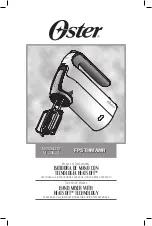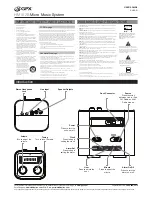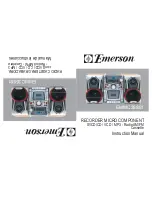
Manual-5
12. SWITCHABLE LOOP SEND jacks: Use these ¼" unbalanced Left and Right Outputs for driving the inputs of a proces-
sor activated by the front panel LOOP button.
13. SWITCHABLE LOOP RETURN jacks: Use these ¼" unbalanced Inputs for receiving the outputs of the above device.
14. MAIN EFFECTS LOOP SEND jacks: These ¼" unbalanced connectors provide drive to the inputs of a signal processor
which is not to be switched from the front of the mixer. Connecting only to the LEFT EFFECTS SEND provides a mono
Output; connecting to both Left and Right provides a stereo feed.
15. MAIN EFFECTS LOOP RETURN jacks: A pair of ¼" unbalanced Inputs for receiving the processed signal generated
from the Main Effects Loop Sends above.
16. Balanced MAIN MIC Input jack: Use this 3-pin connector for connecting a balanced microphone of any impedance,
either dynamic or condenser.
17. Unbalanced high-impedance AUX MIC Input jack: This ¼" unbalanced Input is for wireless or other high-impedance
mics.
18. MIC LOOP jack: This ¼" TRS (Tip-Ring-Sleeve) connector is for inserting external signal processing in the microphone
circuit only. This is a tip-send, ring-return configuration. This feature does not affect the operation of the Main Program
Channels.
19. PHANTOM POWER switch: Engaging this pushbutton a15 V Phantom Power to the 3-pin balanced MAIN MIC
Input only. It has no effect on the Auxiliary Microphone Input. The adjacent red LED illuminates whenever Phantom
Power is active.
20. BOOTH DUCKER switch: When in the ACTIVE position, the ENGAGE MIC switch on the front panel reduces the
Microphone level at the Booth Outputs. When this switch is in the DEFEAT position, Microphone level is not reduced.
21. PHONO/AUX input jacks: Use these stereo Phono Input pairs for connecting any moving-magnet type cartridges to the
mixer. Internal jumpers are provided to convert these into Line level Inputs (See SERVICE INFORMATION, page Sche-
matic-1). When these jumpers are set to PHONO (as shipped from the factory), these Inputs should never be used for any
other purpose due to the amount of gain and RIAA equalization present. Any unused Phono Input should have the Phono
Shorting Plug installed to prevent interference from an outside source. Do not put any of the Phono Shorting Plugs into the
Tape Out jacks, as this will short all the Outputs.
22. AUX/PHONO 3 input jacks: As #21 above, except shipped with the internal jumpers in the LINE position.
23. LINE 1 & 3 through 6 Input jacks: These stereo pairs of RCA connectors are unbalanced, Line level Inputs only. They
are suitable for all line-level devices such as the audio outputs of VCRs, compact disc players, tape recorders, etc.
24. LINE 2 Input jacks: This is a fully balanced, ¼" Tip-Ring-Sleeve Line Input. The tip of the jack is (+), the ring is (–) and
the sleeve is ground.
25. GROUNDING POST: This terminal is provided to facilitate your hum chasing, buzz eliminating experiments. Its purpose
is to provide a place to connect those otherwise unusable extra wires coming out of the turntables.
26. Chassis ground point: A 6-32 screw and toothed washer is provided for chassis ground. Since the MP 24 does not get
chassis ground through the AC cord, this point is provided in case your system does not have another earth ground such as
the rack rails. See the CHASSIS GROUNDING note on page Manual-8 for details.
27. GROUND LIFT SWITCH. This switch separates chassis ground from signal ground. Normally, this switch should be in
the LIFT position. In some circumstances, moving it to the opposite position eliminates stubborn hum and buzz problems.
If you are tempted to move this switch with your power amplifiers turned on and cranked up, don’t. Always turn your
system levels down before changing your grounds around and then bring them up slowly.
28. POWER input connector: No, this is not where Commissioner Gordon plugs in his Bat-phone, in fact it is not a telephone
jack at all. The MP 24 uses an 18 volt AC center-tapped transformer only. Use only a model RS 1, or other remote AC
power supply approved by Rane.


























